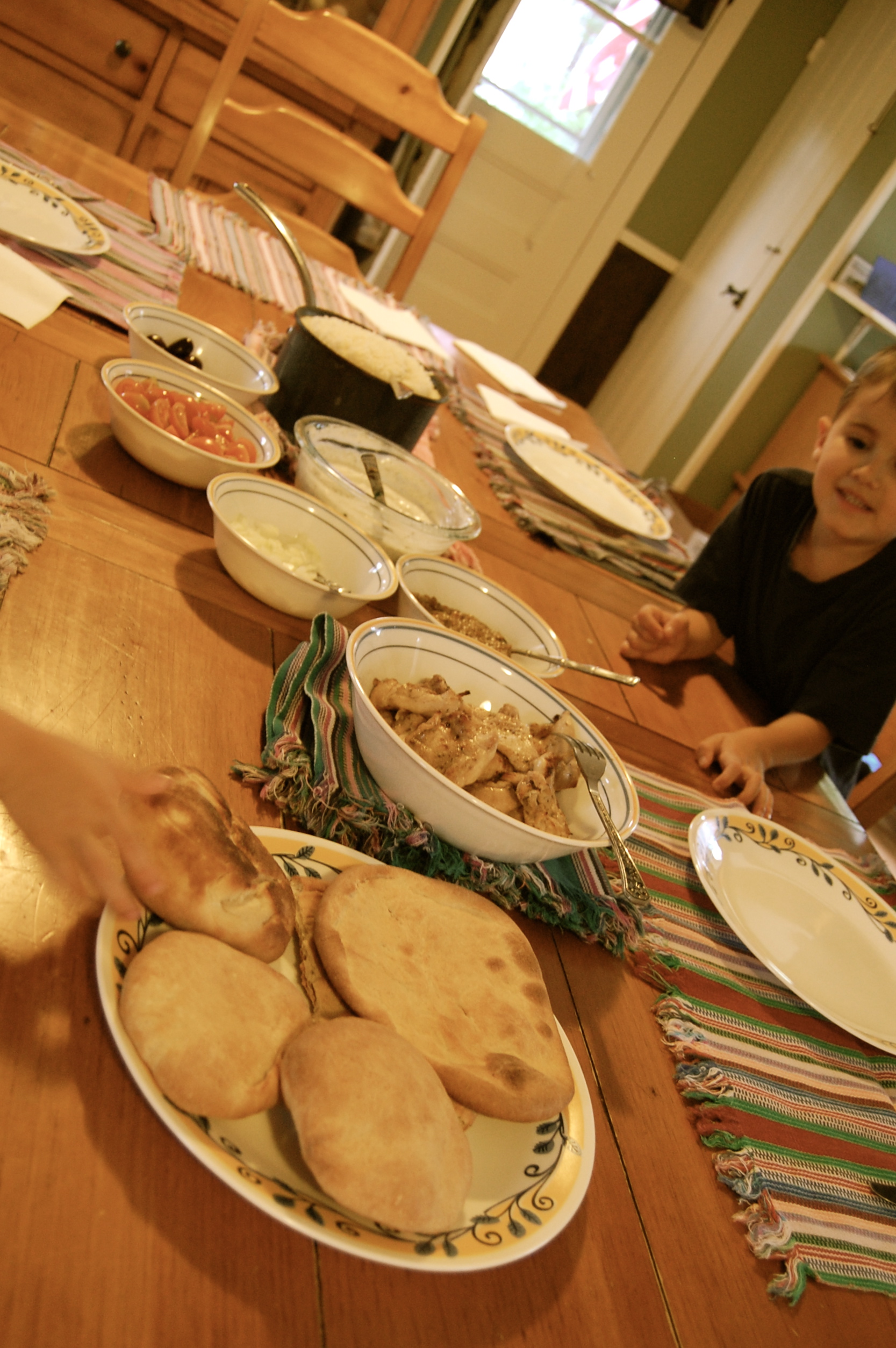I’d like to continue this week’s de facto theme of eating together, but with a bit more of a focus on eating with/feeding children. Obviously, this is a HUGE topic–one to which I will certainly return in future posts–so I’m going to confine my thoughts today to the (still big!) question: “how can I make family dinners that everyone–including the children–will enjoy?”
 It’s a good question. In our own family life, there have been times where my creative cooking energies have been nearly stifled by the complaints of my children. There are at least four basic responses to the problem of kids who don’t want what’s for dinner:
It’s a good question. In our own family life, there have been times where my creative cooking energies have been nearly stifled by the complaints of my children. There are at least four basic responses to the problem of kids who don’t want what’s for dinner:
- change family cooking/eating habits to suit their tastes
- make ultimatums and give the kids nothing until they eat what’s served
- prepare separate dishes for the adults and for the children
- allow the children to choose for themselves what they will eat from what’s being served, and offer one or two reasonable alternatives in the event of a hated-one dish type meal
First, you can probably guess that I’m not a huge fan of changing family cooking and eating habits to suit kids’ tastes. I’m not, but I’m not a legalist on this either: I think making changes within reason make sense. In my time overseas, I noticed that European (particularly Continental) parents make adjustments in the food for their children. So for example, let’s say my friend was going to broil some chicken and vegetables. She might put a curry rub on most of it, but leave a small, separate portion plain for the children. I like this. While there’s always the parents (like mine!) who brag that their kids ate spicy curries at eighteen months of age (which I did) it’s also true that kids are biologically wired to dislike strong and bitter flavors–perhaps a protective mechanism to keep them from eating poisonous plants and such. Making small, reasonable adjustments like this–for example, my kids don’t like chicken breaded, so if I’m making chicken, I leave theirs plain, which isn’t any extra work–seem to me like kindness and good sense.
 Second, making ultimatums and threatening not to feed the child until they eat what’s in front of them. Certainly, there is a time-honored tradition here. And there’s a measure of wisdom, perhaps, too. It’s true that starving people aren’t choosy about what they eat. But think of a food YOU’RE averse to and imagine being told “eat it, and you’re not getting anything else until you DO eat it.” I’m stubborn enough to starve until I convinced whoever was doing this to me to give me something I like, and my kids, unfortunately, inherited this “spirited-ness.” It just doesn’t feel very kind to me. (Have you had experience with this? Tell me your stories!)
Second, making ultimatums and threatening not to feed the child until they eat what’s in front of them. Certainly, there is a time-honored tradition here. And there’s a measure of wisdom, perhaps, too. It’s true that starving people aren’t choosy about what they eat. But think of a food YOU’RE averse to and imagine being told “eat it, and you’re not getting anything else until you DO eat it.” I’m stubborn enough to starve until I convinced whoever was doing this to me to give me something I like, and my kids, unfortunately, inherited this “spirited-ness.” It just doesn’t feel very kind to me. (Have you had experience with this? Tell me your stories!)
Third, preparing separate dishes for adults and children. As a general rule, this is way too much work, which makes it kind of unsustainable. In practice, it can mean relying on convenience foods (frozen chicken nuggets? spaghetti-Os?) to feed the kids while the grownups eat something else. Another thing that I don’t like about this approach is that it doesn’t provide a way for children to learn to eat “grownup” foods–and I do think that this is important. Now, again, I’m no legalist; I’m not going to say that this is something to NEVER do. It makes sense, for example, if you’re having a late, grownup dinner party, to make something simple beforehand for the children, like macaroni and cheese and some steamed vegetables. (Unless you’re me, and your kids hate mac & cheese. Go figure.)
 Finally, #4: “allow the children to choose for themselves what they will eat from what’s being served, and offer one or two reasonable alternatives in the event of a hated-one dish type meal.” Maybe you’ve already guessed that our family falls most comfortably into this approach. In a comment on this post, my colleague and friend Ellen noted that her family often eats meals that are somewhat customizable, like tortillas with a variety of fillings. That way, each person can choose what suits them while still sharing the same basic meal. I like this approach, and I tend to have a fairly relaxed approach in monitoring what my kids choose. This sometimes means that someone ends up eating a tortilla filled with rice (ahem) but more often than not, as I look over the choices my kids make from their reasonably healthy options, it works out to a pretty good balance. (Read about an interesting 1928 research experiment on kids’ food choices here.) In the event of a mostly-one dish type meal (like a stew or a curry) that they don’t like, I am not opposed to letting them eat the bread or rice exclusively, or letting them have some apple slices and peanut butter instead. They don’t get to raid the fridge or place orders, but they can choose to eat the meal or to eat the one, simple alternative we have.
Finally, #4: “allow the children to choose for themselves what they will eat from what’s being served, and offer one or two reasonable alternatives in the event of a hated-one dish type meal.” Maybe you’ve already guessed that our family falls most comfortably into this approach. In a comment on this post, my colleague and friend Ellen noted that her family often eats meals that are somewhat customizable, like tortillas with a variety of fillings. That way, each person can choose what suits them while still sharing the same basic meal. I like this approach, and I tend to have a fairly relaxed approach in monitoring what my kids choose. This sometimes means that someone ends up eating a tortilla filled with rice (ahem) but more often than not, as I look over the choices my kids make from their reasonably healthy options, it works out to a pretty good balance. (Read about an interesting 1928 research experiment on kids’ food choices here.) In the event of a mostly-one dish type meal (like a stew or a curry) that they don’t like, I am not opposed to letting them eat the bread or rice exclusively, or letting them have some apple slices and peanut butter instead. They don’t get to raid the fridge or place orders, but they can choose to eat the meal or to eat the one, simple alternative we have.

Additionally, I do encourage my kids to try at least a bite of everything that’s being served, but in a fun way. I’ll pay them a dime to take one bite of something, or dare them to taste it in the classic frat-boy tradition. It helps to have a sense of humor when eating with kids. I think it’s important to retain a sense of enjoyment at mealtimes, and not let them become quests for nutritional perfection or battles about “how many bites do I have to eat before I can have dessert?” Because (and I’m planning to say more about this, also, in future posts) food is a gift from God, meant for enjoyment as well as nourishment.
And so people with children in their lives, I think, can and should help expand kids’ enjoyment of food as one way of helping them delight in God’s creation.
(and I will say from experience that helping them see where their food comes from–as in gardening or visiting a farm–is one great way to help expand their wonder at creation and gratitude toward God and piquing their interest in vegetables.)











